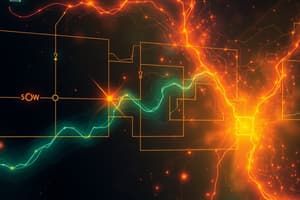Podcast
Questions and Answers
What is a unilateral circuit?
What is a unilateral circuit?
- A circuit with only passive elements.
- A circuit whose properties or characteristics change with the direction of its operation. (correct)
- A circuit whose properties remain the same with the direction of its operation.
- A circuit with only active elements.
What is a node in a circuit?
What is a node in a circuit?
- A point where a circuit element is connected to the ground.
- A point where three or more circuit elements are connected together.
- A point where a circuit element is connected to a source of emf.
- A point where two or more circuit elements are connected together. (correct)
What is a branch in a circuit?
What is a branch in a circuit?
- A part of a network that lies between two nodes. (correct)
- A part of a network that lies between two meshes.
- A part of a network that lies between two nodes and contains at least one loop.
- A part of a network that lies between two loops.
What is a loop in a circuit?
What is a loop in a circuit?
What is a mesh in a circuit?
What is a mesh in a circuit?
What is Kirchhoff's Mesh Law or Voltage Law (KVL)?
What is Kirchhoff's Mesh Law or Voltage Law (KVL)?
How should a rise in voltage be signed in KVL?
How should a rise in voltage be signed in KVL?
What does Kirchhoff's Mesh Law represent?
What does Kirchhoff's Mesh Law represent?
What is the characteristic of a series circuit?
What is the characteristic of a series circuit?
What is the total resistance of resistors connected in series?
What is the total resistance of resistors connected in series?
What is the definition of a branch in a circuit?
What is the definition of a branch in a circuit?
What happens to the current when it gets to point B in a parallel circuit?
What happens to the current when it gets to point B in a parallel circuit?
What is the characteristic of a parallel circuit?
What is the characteristic of a parallel circuit?
What is the condition for a parallel circuit between two points?
What is the condition for a parallel circuit between two points?
What is the total resistance of resistors connected in parallel?
What is the total resistance of resistors connected in parallel?
How can resistors be connected in series?
How can resistors be connected in series?
What is the purpose of using a digital computer in solving network equations?
What is the purpose of using a digital computer in solving network equations?
What is the name of the method that uses a system of loop or mesh currents instead of branch currents?
What is the name of the method that uses a system of loop or mesh currents instead of branch currents?
What is the number of elements in a 2 × 2 determinant?
What is the number of elements in a 2 × 2 determinant?
What is the formula for evaluating a 2 × 2 determinant?
What is the formula for evaluating a 2 × 2 determinant?
What is the current through R4 when it is considered part of the second loop?
What is the current through R4 when it is considered part of the second loop?
What is the advantage of using Maxwell's Loop Current Method over Kirchhoff's laws?
What is the advantage of using Maxwell's Loop Current Method over Kirchhoff's laws?
What is the purpose of assigning continuous paths to loop currents in Maxwell's Loop Current Method?
What is the purpose of assigning continuous paths to loop currents in Maxwell's Loop Current Method?
What is the formula for evaluating a determinant in terms of its elements?
What is the formula for evaluating a determinant in terms of its elements?
What does Norton's theorem reduce a two-terminal active network to?
What does Norton's theorem reduce a two-terminal active network to?
What is the equivalent current source in Norton's equivalent circuit designated as?
What is the equivalent current source in Norton's equivalent circuit designated as?
What is the equivalent resistance in Norton's equivalent circuit designated as?
What is the equivalent resistance in Norton's equivalent circuit designated as?
What is the voltage between any two points in a network equal to?
What is the voltage between any two points in a network equal to?
How is RN defined in Norton's theorem?
How is RN defined in Norton's theorem?
What happens when a load resistor is connected between the terminals of a Norton's equivalent circuit?
What happens when a load resistor is connected between the terminals of a Norton's equivalent circuit?
What is the purpose of Norton's theorem?
What is the purpose of Norton's theorem?
What is the current which would flow in a short-circuit placed across the terminals of a Norton's equivalent circuit?
What is the current which would flow in a short-circuit placed across the terminals of a Norton's equivalent circuit?
What is the first step in finding the Norton equivalent circuit?
What is the first step in finding the Norton equivalent circuit?
What is the overall efficiency of a network supplying maximum power to any branch?
What is the overall efficiency of a network supplying maximum power to any branch?
What is the goal in the case of electronic and communication networks?
What is the goal in the case of electronic and communication networks?
What is the application of the Maximum Power Transfer Theorem limited to?
What is the application of the Maximum Power Transfer Theorem limited to?
What is the first step in using the Determinant and Cramer’s rule in solving DC networks?
What is the first step in using the Determinant and Cramer’s rule in solving DC networks?
What is the difference between Self resistance and Mutual resistance in mesh analysis?
What is the difference between Self resistance and Mutual resistance in mesh analysis?
What is Kirchhoff’s Current Law (KCL) used for?
What is Kirchhoff’s Current Law (KCL) used for?
What is the significance of the Maximum Power Transfer Theorem in electronic and communication networks?
What is the significance of the Maximum Power Transfer Theorem in electronic and communication networks?
Flashcards are hidden until you start studying
Study Notes
Series Circuit
- A series circuit is defined as a circuit that provides only one path for current between two points, so that the current is the same through each series resistor.
- There is no limit to the number of resistors that can be connected in series.
- The total resistance in a series circuit is the sum of each of the individual resistors: RT = R1 + R2 + R3 + … + Rn.
Parallel Circuit
- A parallel circuit is identified if there is more than one current path (branch) between two points, and if the voltage between those two points also appears across each of the branches.
- Each parallel path in a circuit is called a branch.
- The equivalent current distribution in a parallel circuit shows the current out of the source dividing when it gets to a point, and then coming back together at another point.
Unilateral Circuit
- A unilateral circuit is one whose properties or characteristics change with the direction of its operation.
- A diode rectifier is a unilateral circuit because it cannot perform rectification in both directions.
Passive and Active Networks
- A passive network is one that contains no source of e.m.f.
- An active network is one that contains one or more sources of e.m.f.
Circuit Elements
- Node is a junction in a circuit where two or more circuit elements are connected together.
- Branch is that part of a network that lies between two junctions.
- Loop is a closed path in a circuit in which no element or node is encountered more than once.
- Mesh is a loop that contains no other loop within it.
Kirchhoff's Mesh Law (KVL)
- Kirchhoff's Mesh Law or Voltage Law (KVL) states that the algebraic sum of the products of currents and resistances (IR) in each of the conductors in any closed path (or mesh) in a network plus the algebraic sum of the emfs in that path is zero.
- It can be stated as: in any closed electric circuit, the sum of potential drops (I.R) is equal to the sum of the impressed emfs.
Determinants and Cramer's Rule
- Determinants provide a simple and straightforward method for solving network equations through manipulation of their coefficients.
- The symbol |a b| / |c d| is called a determinant of the second order (or 2 × 2 determinant).
- The numbers a, b, c, and d are called the elements or constituents of the determinant.
Maxwell's Loop Current Method
- This method is particularly well-suited to coupled circuit solutions and employs a system of loop or mesh currents instead of branch currents.
- It eliminates a great deal of tedious work involved in the branch-current method and is best suited when energy sources are voltage sources rather than current sources.
Norton's Theorem
- Norton's theorem states that any two-terminal active network containing voltage sources and resistance, when viewed from its output terminals, is equivalent to a constant-current source and a parallel resistance.
- The equivalent current source is designated IN, and the equivalent resistance is designated RN.
- The voltage between any two points in a network is equal to ISC.Ri, where ISC is the short-circuit current between the two points and Ri is the resistance of the network as viewed from these points with all voltage sources being replaced by their internal resistances.
Maximum Power Transfer Theorem
- The theorem is applicable to all branches of electrical engineering, particularly useful for analyzing communication networks.
- The overall efficiency of a network supplying maximum power to any branch is 50 per cent.
- The application of this theorem to power transmission and distribution networks is limited because, in their case, the goal is high efficiency and not maximum power transfer.
Studying That Suits You
Use AI to generate personalized quizzes and flashcards to suit your learning preferences.




